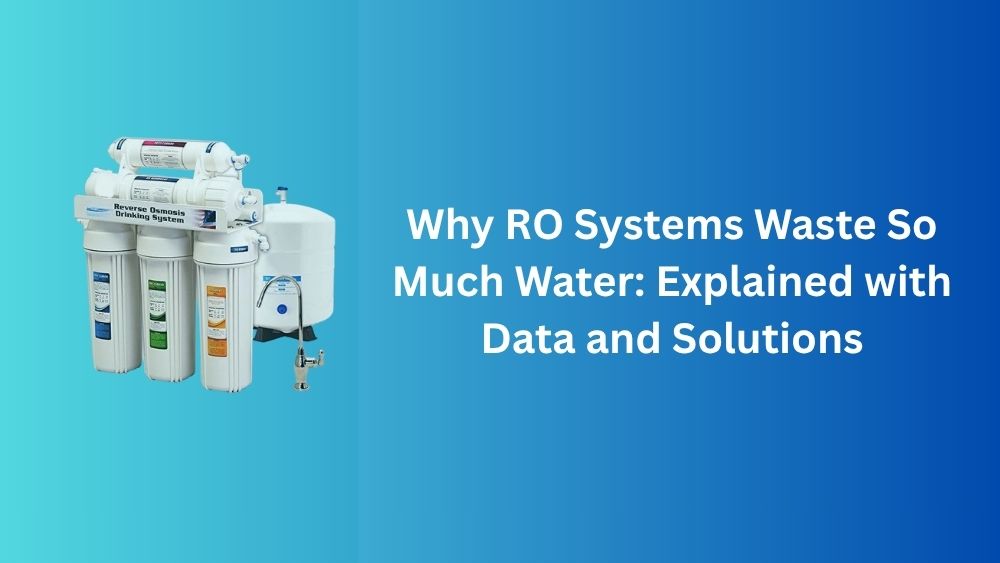Reverse osmosis systems are trusted for making drinking water safer by removing dissolved salts, heavy metals, and many micro-contaminants. The tradeoff people notice is the reject stream that carries away those concentrated impurities. That stream is often called waste water, but it exists to keep the membrane clean and your water quality consistent.
Older home units could use four to nine gallons of feed water to produce a single gallon of purified water. Newer designs are better, yet the reject line can still look surprising at the sink. The EPA notes that efficient point-of-use models can reduce waste to roughly 2.3 gallons per gallon of product water when properly designed and maintained.
Recovery rate is the key efficiency metric. It is the share of feed water that becomes purified water. Commercial systems often reach 50 to 85 percent recovery when pretreatment and pressure are optimized. Typical under-sink units are lower because they face variable household pressure, temperature, and water quality.
Your water’s TDS, the inlet pressure, membrane condition, and flow-restrictor sizing all influence how much water goes to the drain. Higher TDS and lower pressure push waste upward. Good pretreatment, regular service, and healthy pressure bring it down. For the basics on measuring dissolved solids, see what is TDS in water and why you should measure it.
-
Key takeaway Reduce waste by improving recovery with maintenance, pretreatment, and modern components rather than trying to eliminate the reject stream entirely
Typical RO Waste Ratios
| System type | Recovery rate | Waste ratio per 1 gallon purified | What this means |
|---|---|---|---|
| Older residential RO | 10 to 20 percent | 9 to 4 | Very inefficient, often due to fouling and low pressure |
| Typical residential RO | 20 to 25 percent | about 4 | What many households observe |
| WaterSense-style efficient residential | 30 to 35 percent | up to about 2.3 | Requires better design and maintenance |
| Industrial or commercial brackish water | 50 to 85 percent | 1 to 0.2 | Tuned pretreatment and pressure control |
If you include a graphic, a simple bar chart that compares waste ratios across those four categories helps readers see the improvement from older to efficient systems.
Why RO Waste Exists in the First Place
Reject water is not a design flaw. The membrane blocks salts and many contaminants, and the concentrated mixture must be swept away to prevent scaling and biofouling. Without that flow, production would slow, quality would fall, and the membrane would fail early. For real-world maintenance context, point readers to how often should RO membrane be replaced and how often should you service your RO water purifier.
Practical Ways to Reduce RO Wastewater at Home
Modern components and simple habits make a large difference. A permeate pump or a tankless high-efficiency unit can raise recovery. Sediment and carbon pretreatment reduce fouling so you do not need as much flush flow. If you are doing a deep clean or seasonal checkup, see how to clean and sanitize an RO system. Many homeowners also find value in choosing a higher quality membrane as covered in best 100 GPD RO membrane. Finally, if local rules allow, reuse the reject water for safe nonpotable tasks. Your guide how to reuse waste water gives easy ideas for the home.
Cost and Performance Context
Efficiency influences cartridge life, membrane life, and total cost of ownership. Readers who are budgeting upgrades can review reverse osmosis system cost. If they are comparing technologies rather than components, send them to RO vs UV water filters to understand when RO is essential for dissolved minerals versus when a non-RO option might be enough.
Expert Opinion
Independent membrane consultants frame the goal this way. Do not chase zero waste with RO. Aim for stable recovery that protects the membrane and meets your daily volume. The quickest wins usually come from pretreatment, pressure management, and a permeate pump or efficient tankless unit. In homes those steps lower waste and extend membrane life without sacrificing water quality.
FAQs
Does RO always waste a lot of water?
Not always. Inefficient home units can waste four to nine gallons per gallon purified, but well-designed point-of-use systems can cut that to about 2.3.
What single factor most affects my waste volume?
Feed water quality and pressure. Higher TDS raises osmotic pressure and increases the flush you need. For background on measuring dissolved solids, see what is TDS in water and why you should measure it.
Can I safely reuse the reject water?
Yes for nonpotable tasks like floor cleaning, garden use where appropriate, or toilet flushing. See how to reuse waste water for simple methods.
Which maintenance items help the most?
Timely membrane and prefilter changes and periodic sanitation. Start with how to clean and sanitize an RO system and how often should you service your RO water purifier.
Does RO also help with specific contaminants?
Yes for many. For examples and deeper reading, see does reverse osmosis remove lead, how RO systems remove arsenic from drinking water, and does RO kill bacteria and viruses effectively.
Closing Note
RO systems waste water because that is how membranes stay clean and your water stays safe. With good maintenance, smart component choices, and sensible reuse, you can shrink that waste while keeping top-tier water quality.

Hasan Al Sarker is a Reverse Osmosis Specialist. He has worked for many years to ensure safe drinking water for all. His research paper has been published in several journals, including Issue, Medium, and Slideshare. He is recognized as a water doctor among specialists though he did not attend medical college.
Besides working as a researcher of reverse osmosis technology, he is also very fancy with the kitchen and cooking. His guides are reading thousands of people every day. As a head of content, he is responsible for all the published articles at RO System Reviews.

